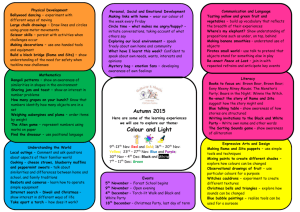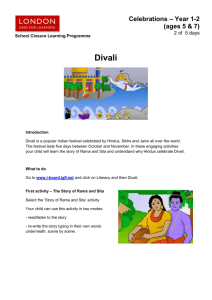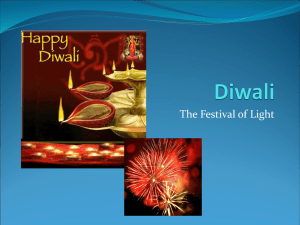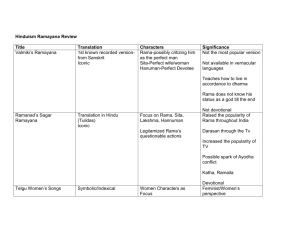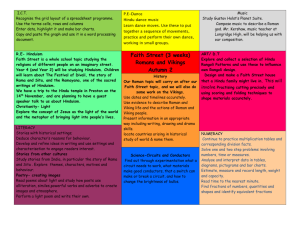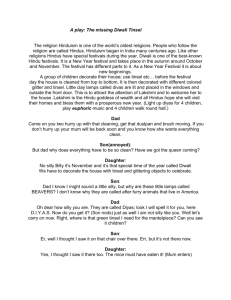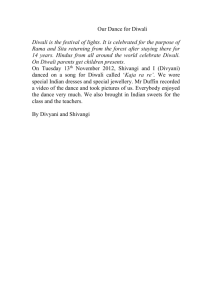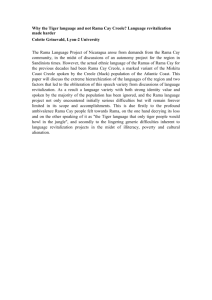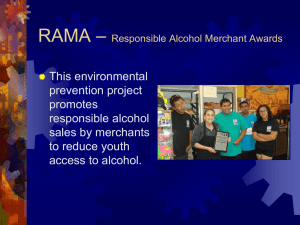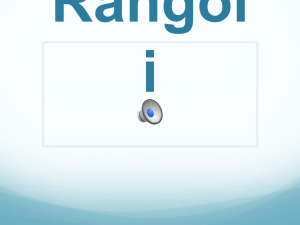Teaching ideas and activities for Divali
advertisement
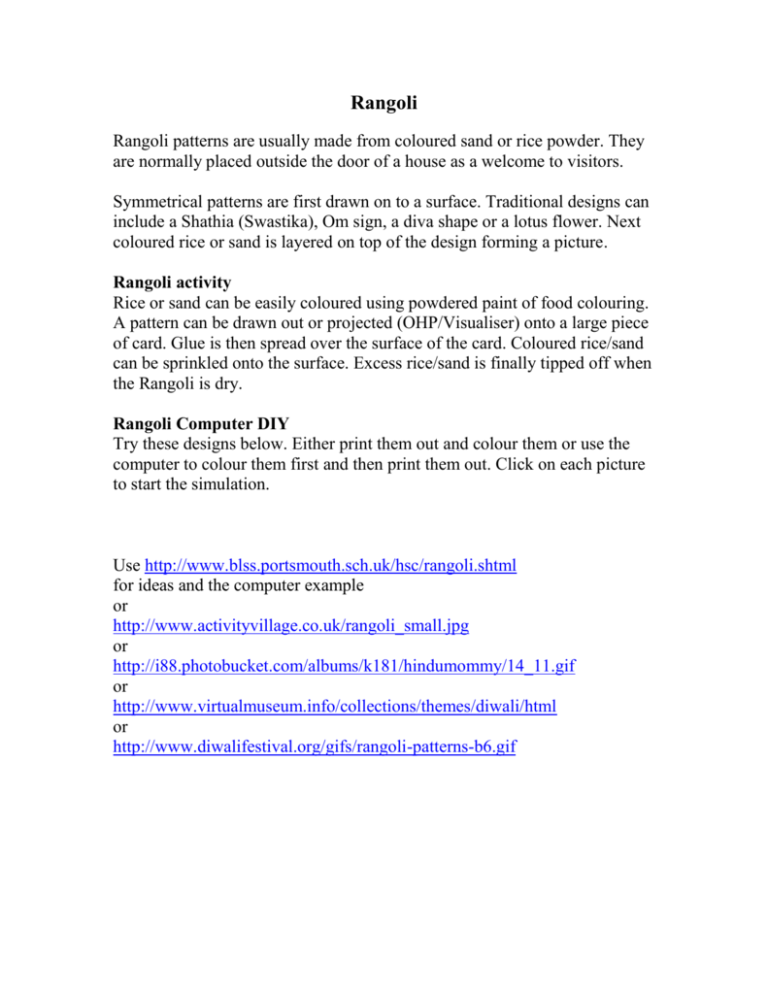
Rangoli Rangoli patterns are usually made from coloured sand or rice powder. They are normally placed outside the door of a house as a welcome to visitors. Symmetrical patterns are first drawn on to a surface. Traditional designs can include a Shathia (Swastika), Om sign, a diva shape or a lotus flower. Next coloured rice or sand is layered on top of the design forming a picture. Rangoli activity Rice or sand can be easily coloured using powdered paint of food colouring. A pattern can be drawn out or projected (OHP/Visualiser) onto a large piece of card. Glue is then spread over the surface of the card. Coloured rice/sand can be sprinkled onto the surface. Excess rice/sand is finally tipped off when the Rangoli is dry. Rangoli Computer DIY Try these designs below. Either print them out and colour them or use the computer to colour them first and then print them out. Click on each picture to start the simulation. Use http://www.blss.portsmouth.sch.uk/hsc/rangoli.shtml for ideas and the computer example or http://www.activityvillage.co.uk/rangoli_small.jpg or http://i88.photobucket.com/albums/k181/hindumommy/14_11.gif or http://www.virtualmuseum.info/collections/themes/diwali/html or http://www.diwalifestival.org/gifs/rangoli-patterns-b6.gif Make a Hanuman mask To make your mask you will need: Dark brown card Lighter brown card Pink card (or paint) Gold card (or white card and yellow paint) Paintbrushes Scissors Pencil Glue Glitter, sequins and paint to decorate the mask Elastic or string to tie your mask Stage 1 Draw two large circles, one on the dark brown card and one on the lighter brown card. Make sure the circles are wide enough to cover your face. Cut out both shapes. Place the light brown card halfway over the dark brown card to make Hanuman’s face. Glue the pieces together. Stage 2 Make two eyeholes in the dark brown card circle. Draw two ear shapes on the light brown card and cut them out. Draw a little round nose shape on pink card and cut it out (or use white card and paint it pink later). Draw a crown shape on gold card and cut it out (or use white card and paint it gold later). Now stick the ears, nose and crown onto your mask. Stage 3 Now it is time to decorate your mask. Paint a big curved smile from edge to edge across the light brown circle. If you used white card, paint your pink nose and yellow crown. Decorate your crown and mask with glitter, sequins and paint. Make two small holes at either side of the top circle and thread with some elastic or string. Now you can wear your mask and be King of the Monkeys!! A Divali Puppet Theatre Show What you will need to make a shadow puppet: Black card Pencil Split pins Scissors Sticks or small garden canes Sellotape What to do: On the black card, draw your character in profile (as if you are looking from the side). Make sure your characters are about the same size and they will fit your theatre (see below). If you wish you can use the split pins to make your characters limbs move. Use a piece of garden cane or thin stick to make a rod for your puppet by sellotaping it to the back of the puppet. What you will need to make a shadow puppet theatre: A large and strong cardboard box A piece of white muslin or thin white paper, big enough to fit the side of your box Sellotape Scissors Dark paint, sequins, feathers and stars to decorate Weights A bright lamp or torch or the beam from an OHP What to do: Turn the box upside down. Carefully cut away one of the largest sides, leaving a border at the edge. This will be the front of the theatre. Next cut away the back of the box and make two long thin holes in the side of the box big enough to slide your puppets through. This will be how the puppets enter and leave the stage. Paint the box in dark colours and decorate the front with sequins or glitter and stars. When the paint is dry, attach the muslin or thin white paper to the inside of the theatre to make a screen. Shine the light from behind and hold the stick attached to the puppet and slide the puppet through the side slit. The puppet will then appear as shadow on the screen and can act out while someone tells the story. Footprints The tradition says that if the goddess of wealth and good fortune, Lakshmi, is to find her way to your house you not only have to light up the house with divas (lamps) but you can show her the way by laying a trail of footprints to your door. Trace round the children’s feet (preferably leaving their shoes on!). They can put their toes in if they wish and then colour in the outlines of the feet and cut them out. They should then have some brightly coloured feet that bear some relationship to the shape of their feet. These outlines of feet can be placed outside the door to show Lakshmi the way to the classroom. Don’t forget to remind the children to put their names on the back of each of their footprints. It might solve problems later if they wish to take them home. Make a Divali purse Divali is the time when all financial affairs are sorted out. Children can make a little purse out of felt or cloth material or strong paper and (if allowed in these days of healthy eating) they can put a silver or gold piece of chocolate money in it to take home. What you will need to make a purse: A piece of cloth, felt or card Scissors Glue Sellotape Piece of brown card /felt/card Piece of yellow card/felt/card. A small present to put in the purse. A needle and a range of colours of embroidery thread What to do: Cut out the cloth or felt so it is big enough to hold the coin when the sides are sewn up. It should be cut in a rectangle about 15 by 10 cms. Fold the cloth over in half and carefully sew three sides together – making sure there will be enough space so you can still fit your coin inside. When you have sewn the three sides together, turn the purse inside out if it is material or felt (if you have used card you won’t be able to turn it inside out) so the stitches are on the inside. Cut out the shape of a small diva lamp and stick it on the front using the brown material. Then cut out a small yellow flame shape from the yellow material and stick it so it looks like the flame on the lamp (diva). You can then slide your coin into the space at the top and you have a Divali present to give to someone. DIVALI Divali is the most important Hindu festival. It falls in October-November every year. Divali is a shortened form of Deepavali – a line of lamps. It is the most important time for bankers, merchants and business people as the most important aspect is the worship of LAKSHMI, the goddess of wealth. It lasts for five days and each day has a particular importance. A diva – lamp is lit on day one and is placed in the front of the house as an offering to Yama, the god of death. It points south which it must never do during the rest of the year. On day two there is the story of Krishna saving 16.000 young women who had been captured by the demon, Narakasura. Families put on new clothes, firecrackers are let off in the evening, there are special sweet dishes and the houses are illuminated with oil laps. On day three Lakshmi is worshipped in every house symbolised by a gold ornament or a silver rupee. All doors and windows are opened to welcome Lakshmi and rangoli patterns are drawn on the floor near the entrance to the house. The house is lit with lamps so Lakshmi can see her way clearly. This day is the day when all the financial dealings are settled and close. On day four, married women receive a special gift from their husbands and it s the day when new undertakings are started as the new financial year begins. On day five, often called Sister’s Day, husbands have to go to eat at their sisters’ house. He is warmly welcomed, fed and anointed with oil. He gives her a present and is able to return home after midday. During this time famous stories are told or re-enacted which exemplify family values. The story of Rama and Sita is such a story with its triumph of good over evil and the love and loyalty shown by Rama, his wife, Sita, and his brother, Lakshman. Divali to go! In the handout there are a range of activities you will be able to do with your pupils. On the tables you will be given a range of materials and you should aim to complete as much as you can in the time. This will give you some idea of the length of time children might need. We will have watched video/DVD on Divali so you will have a clearer idea of what the festival is about and you are expected to make a diva out of the clay and night-lights that will appear. There are some very good websites on Divali and these are in the handout and in the Handbook you were given in Year 1. You will find that one site allows you to create a rangoli pattern on the computer and this may be an excellent activity for some children. Some Hindus will paint their hands and if you wish to do this you are very welcome but take care when you handle things as the henna may run. We have some Indian sweets which you may like to try but please don’t waste them! There are some spices in the tray you will receive and the idea of this is that spices are an important part of Indian cookery but you may like to add water and mix them into pastes which you can then use to make a rangoli pattern. If you wish, you can use one of your group as the template for coloured footprints which show Lakshmi, the goddess, the way to your house. Someone take off their shoes and socks, draw round the feet on paper or card and then colour the imprints in a variety of colours. If two or three of you did this you would have a trail of footprints leading to the door but it may be you prefer to use the same template several times on the grounds of hygiene and social concern for others in the near vicinity! The Story of Rama and Sita Many years ago in India there lived a great king. His name was Dashratha and he ruled over the kingdom of Ayodhya. He had three wives and four sons. His sons were all very talented and good people, especially the eldest, Rama, who was heir to the throne. Rama had been given special powers by the gods and he used these powers to destroy evil demons who were causing trouble in the world. Among the chief trouble makers was the demon king called Ravana. When Dasratha’s four sons were grown up, the king chose Rama to be the next king but this caused great quarrels in the family. Queen Kaykayi, one of King Dasratha’s wives, was jealous that her son was not chosen to be king. She told her husband untrue stories about Rama. The king, when he heard them believed them to be true and banished Rama from the kingdom for fourteen years. He went into the forest with another brother, Lakshman. The third son was placed on the throne but he was angry with his mother because of the lies she had told about Rama. He took a pair of Rama’s golden slippers and placed them on the throne as a symbol of Rama’s rightful place. He said, ‘I will look after Rama’s kingdom until he returns and he himself removes his slippers from the throne.’ Rama had a beautiful wife called Sita but he was afraid to take her away with him and left her at home with her mother. Sita missed Rama, however, and she went to look for him in the forest. When she found him, Rama built a hut for her so she would be safe. Whenever he had to leave her, he drew a magic ring around the hut telling her to stay inside the ring for she would be safe there. The demon king, Ravana, was very jealous of Sita and wanted her for himself. One day he changed himself into an old sannyasi, a holy man, and went to Sita’s hut. He called to her, asking for food and Sita, thinking he posed no threat, left the safety of her hut and went to give him some food. Ravana changed back into the demon king and seized Sita. He gathered her up and flew with her to the island of Lanka. Rama was very upset when he arrived back and found Sita had disappeared. He and his brother began to search for her. He asked the monkey king, Hanuman, to help him and the army of monkeys spread out across India. They discovered that Sita was a prisoner on the island of Lanka. They had no boats to cross to the island but Hanuman ordered his monkey army to make a bridge out of their bodies so Rama could cross over to Lanka. They did as they were told and an amazing bridge was created. There was a fierce fight which lasted for nine days. Rama was injured but Hanuman raced back to the Himalayas in the far north of India and brought a mountain back with him on which grew a special herb which healed Rama. With renewed strength Rama attacked the demon Ravana and killed him. Ravana’s body was thrown into the fire. Sita was overjoyed to see Rama. They left Lanka together and with Lakshman and Hanuman returned to the kingdom of Ayodhya where the people lit divas to welcome them home. Rama picked up his golden slippers from the throne and accepted the title of King of Ayodhya with Sita as his beautiful loyal queen. Divali Sweets Uncooked Sweets for Divali Recipe 1 BEWARE THE NUTS IN THIS You will need: 1 large tin and 1 small tin of condensed milk 2 packets of desiccated coconut 200 gs (7oz) of ground almonds 1kg (7oz) icing sugar 110m gs (4oz) of chopped nuts A pinch of ground cardamom A pinch of grated nutmeg A few strands of saffron What you do: Mix all the ingredients together. Either spread the mixture in trays and cut into pieces, or roll into small balls. Place in paper cases and sprinkle with icing sugar and nutmeg. OR Recipe 2 What you need: 1 large tin of condensed milk 1 large packet of coconut Pink food colouring What you do: Mix it all together, put into very small sweet cases in a ball shape. Put into fridge to eat cold. Divali Poems Diwali The sweet smell of flowers The array of colours Diwali is here Firecrackers are heard Candles are lit Children play Presents are given We pray to the gods Diwali is here. Suprina Balasubrumanian (age 11) Happiness of ‘Diwali’ Joy, Joy, Joy We can play with our cousins We can eat so many sweets We can fire crackers We can worship Goddess Lakshmi because It is Diwali Happy Diwali K. Anusha (8B) Bhawan’s International School Deepavali Delights Deepavali is here, Deepavali is here That grand festival of Lights That ends evil after a protracted fight When good with all its might Leads us from darkness to Light. Deepavali is here, Deepavali is here That great festival of sound When crackers and laughter abound When crackers and sparklers light up the sky When delighted children jump with joy. Deepavali is here, Deepavali is here That gorgeous festival of snacks and sweets Where everyone enjoys a royal feast When old and young with delight meet With love and affection all hearts beat. Diwali is here, Diwali is here That gracious festival which celebrates victory The ancient festival of myth and mystery That is mentioned in both mythology and history The festival that signals Triumph over Tragedy. Shyam Phatak
